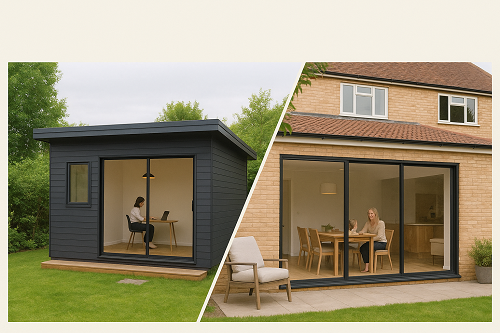Choosing between a backyard studio and a home extension depends on your lifestyle, budget, and how you plan to use the extra space.
Both options add value to your property, but the right choice hinges on what fits your day-to-day needs and long-term plans.
Understanding the differences will help you make a smart choice that suits how you live and what you want from your home. Keep reading to understand the benefits and drawbacks of each so you can decide what’s best for your lifestyle.
What Are Backyard Studios?
A backyard studio is a separate, standalone building in your garden. You can use it as a home office, gym, art studio, or guest room. It’s quick to install and usually costs less than a traditional extension.
Because it’s detached, it gives you privacy and reduces noise inside your home. You can move them or update the design later if needed.
They also need less disruption during construction since they don’t involve changing your existing home structure. Many come as prefabricated kits, which speeds up the build process.
What Are Home Extensions?
A home extension is a built-in addition to your existing house. It increases your indoor living space, like adding a bigger kitchen, bedroom, or living room.
Extensions usually cost more because they involve construction inside your home. You’ll need planning permission, architects, and builders for a seamless look and function.
They can add more value to your property because the extra space feels fully integrated, not separate. However, extensions cause more disruption since your home is being altered, often for several months.
In short, extensions give you more permanent space but require higher investment and time.
Which Is the Best Choice for Your Lifestyle
Each option, a backyard studio or a home extension, offers different advantages depending on your needs and living situation. Let’s explore a few of the factors that will help you select the right option depending on your lifestyle.
#1 Cost and Value Considerations
A backyard studio usually costs less to build compared to a home extension because it’s a separate, smaller structure. This can be ideal if you want an office, gym, or guest space without a major investment.
Home extensions tend to be more expensive. They require more building work, often including plumbing and electrical upgrades. However, these costs may increase your home’s overall living space, which can add more value to your property.
If the budget is tight, a backyard studio is a flexible way to add functional space quickly. If you want to increase your home’s size and long-term living options, an extension could be worth the higher cost.
#2 Planning and Approval Processes
Building approvals can vary between a backyard studio and a home extension. Backyard studios sometimes qualify as "ancillary" buildings, which means the approval process can be simpler and faster.
Home extensions usually require council approval, especially if they affect neighbouring properties or change the building’s footprint significantly. This process can take longer and might involve more rules on design and height.
You’ll need detailed plans and permits either way, but backyard studios often face fewer restrictions. Knowing council rules early on helps you avoid delays and unexpected costs.
#4 Impact on Property Value
Both backyard studios and home extensions can increase your property value, but in different ways.
A home extension adds an integrated living space, which appeals to most buyers and boosts your home’s resale potential. It often improves the flow and function of your existing house.
A backyard studio offers versatile space that can be used for work, hobbies, or as a rental unit. This can attract buyers looking for separate, flexible areas, but it doesn’t add to the main house’s living area.
Think about what buyers in your area prefer when considering the potential return on investment.
#5 Long-Term Practicality
Consider how you plan to use the space over time. A home extension gives you permanent, cohesive living areas. This suits growing families or those needing more bedrooms or living rooms.
A backyard studio works well for flexible uses like a home office, art studio, or guest accommodation. It keeps your existing home intact and can be adapted if your needs change.
Also, think about accessibility. A home extension is usually easier to access for all family members, including those with mobility issues, while a backyard studio might require walking outside to reach it.
Choose the option that fits your daily life and future plans best.
Bottom Line
When choosing between a backyard studio and a home extension, think about your lifestyle needs first. A backyard studio offers flexibility, quick setup, and minimal disruption.
A home extension, however, adds value to your house by increasing living space directly connected to your home.
Keep your budget, timeline, and how you want to use the extra space in mind. Both options work well, but fit different priorities.
You can also consult with professionals to make sure you choose the best option for your home and lifestyle.


































